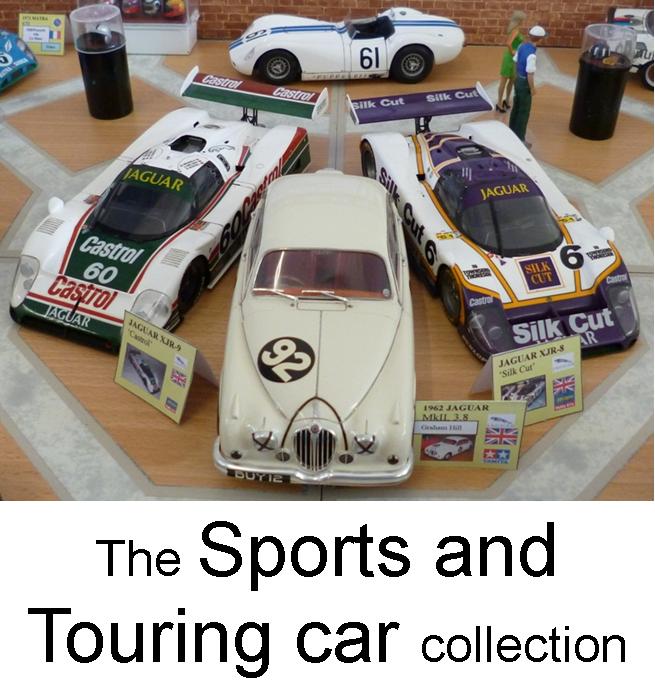
Bentley racing & the 1927 le Mans 24hrs winning car.
W.O. Bentley wasn’t just an engineer, a racer himself on two, and four, wheels he was passionate about competition. Although not the primary aim of his new company in 1919 it was an important consideration. W.O. completely understood the value of motor sport in developing, proving and publicising his products, as he himself put it: “The racing policy was part of the very foundations of Bentley Motors, for the two vital purposes of testing and publicising our cars.”
Autocar magazine is quoted as saying the new 3-litre car Bentley was developing was - “intended to appeal to those enthusiastic motorists who desire a car which, practically speaking, is a true racing car with touring accessories”. The 3-litre Bentley certainly proved itself a strong, durable, high-performance machine and easily fitting into both categories.
W.O. also understood how vital teamwork was, not only within the sphere of competition but within the design, engineering and development realms. So, as his design attracted more and more attention, he was happy to see them race and only too happy to work with his customers assisting them in their racing ambitions.
This became embodied in the Bentley works team of the 1920s, and support of the privateers and the Bentley Boys, which made Bentleys dominant at le Mans during that period.
1921
In a world where circuit motor racing was in its infancy Brooklands was the 'Ascot of Motorsport', in fact many of the horse racing term are still used in motor racing today. Races on the famous banked corners of the concrete auto-drome were often ‘handicapped’ so large and small cars raced at the same time. Complicated, but fair. Brooklands also had a trials area and its own hill to climb so competitions were frequent and varied; just what you might want to develop and prove a cars design.
W.O. Bentley understood the opportunity Brooklands presented and while the 3-litre Bentley was still in its evolution “EXP 2” would make Bentleys competition debut and take the firms maiden victory in 1921.
Little more than an experimental ‘mule’, EXP2 had a plain 2-seater body originally, but coachbuilders JH Easter, of Chagford Street, rebodied the car with a sportier two-seat body in March 1921. Now in a deep red colour and featuring an aluminium bonnet and chromed radiator shell the car looked very hansom indeed. EXP2 had its first race on Saturday the 7th of May, 1921, when Bentley works driver Frank Clement took the start in an event at Brooklands. Although it didn’t fair that well on the day EXP2 would soon take Bentley’s first race win, on Monday the 16th of May, again at Brooklands, in the Whitsun Junior Sprint Handicap.
Countless more victories would follow for production 3-litre models while EXP2 continued its development and racing career throughout 1921 and 1922 until it was sold on the 7th of September 1923, to E.R. Foden, the famous lorry manufacturer.
1922
The first major international event Bentley competed in was the Indianapolis 500 of 1922. A race usually dominated by ‘specials’, often based on Duesenberg racing chassis’, the idea of taking them on with a heavier road car chassis must have been a little daunting.
On the 30th of May, 1922, works driver Douglas Hawkes, with H. S. "Bertie" Browning beside him as the riding mechanic started the race from 19th position on the grid. They complete all 500miles (800km) of the “Five-Century Grind”, and finished 13th at an average speed of 74.95.
A few weeks later the same car was back in England as part of a three-car team for the 1922 Tourist Trophy for cars held on the Isle of Man on the 22nd of June. Wearing racing numbers 3, Frank Clement, 6, Douglas Hawkes and 9, W. O. Bentley (#6 being the Indianapolis car), the cars took to the circuit sporting flat-fronted radiators for reduced frontal area. Looking noticeably different the cars all finished race, which was 8 laps of the 37.75mile circuit. They were ranked 2nd, 5th and 4th respectively with Clement’s average speed being 55.21mph. Henry Segrave set the fastest lap for Sunbeam but didn’t finish, although his STD (Sunbeam/Talbot/Darracq) his team mates Jean Chassagne & Robert Laly won the race, but Bentley won the team award.
Later in the year Bentleys made some more history back at Brooklands. Over the 27th and 28th of September, 1922, John Duff ran a 3-litre Bentley to set a series of International Class D records for 3, 6 & 12 hours, at 88.74mph, 88.79mph and 87.42mph respectively. Due to local law there was never any night running at Brooklands so unable to do a 24hr run Duff did a “Double-Twelve” and ran the Bentley for 2,083miles, averaging 86.79mph; overall, a satisfying end to the 3-litres first season of competition.
1923
1923 turned out to be a land mark year for motor sport with the running of the inaugural “Grand Prix d'Endurance de 24 Heures” held in the Pays de la Loire on a 10.726mile temporary road circuit at Le Mans. Unlike today the track was not a smooth hard surface but an unsealed gravel and tar common road. Great for drifting around corners but not so good for the lights and fuel tanks, not to mention the stones that made it up to hit the drivers themselves!
All but three of the entries for the newly-announced event were French. The first entry received by the ACO (Automobile Club de l'Ouest) being a private entry from John Duff who wanted to race his own 1922 record-breaking 3-litre Sport Bentley; Registration # XM6761 Ch#141. The other ‘foreign’ cars being Belgian Excelsiors.
Duff was actually a new London agent for Bentley and approached W.O. Bentley for his thoughts; and perhaps some support. W.O. was sceptical and was initially opposed to the idea, even going so far as to say “I think the whole thing is crazy,” “Nobody will finish. Cars aren’t designed to stand that sort of strain for 24 hours.” Fortunately, Duff was quite persuasive and W.O. gave his permission for his test driver Frank Clement to co-drive with Duff and begrudgingly supplied spares and a couple of Bentley mechanics for support. The four men loaded up the car with their spares, tools and luggage and drove to race. Interestingly Duff had been convinced by one Lionel Rapson that he could save some weight, and therefore increase speed, by not carrying a spare wheel. So, the Bentley ran on special long-endurance tyres from the Rapson Tyre and Jack Co. It is believed that Rapson shod cars had broken over 50 world records by the end of 1924.
The le Mans event was planned to run over the 26th and 27th of May, 1923, in an effort to reduce the chances of foul weather. An interesting aside here is that the date also coincided with the French change to “summer time”, meaning the race would have started at 4pm on Saturday, and finish at 5pm on the Sunday!
A short time before the event W.O. Bentley suffered an attack of guilt and decided to attend the ‘crazy’ race. Along with Mr. Hillstead, Bentley’s sales executive, W.O. caught the over-night ferry to Dieppe then took the train to La Sarthe. The pair arrived at the race in the nick of time to take over the team organisation and running of the pit.
The organizers efforts to avoid bad weather didn’t work out as when the race started at 4pm a hail storm hit the circuit. Duff, wearing neither helmet nor goggles, kept his 3-liter Bentley up with the leading French Chenard-Walckers, as the hail storm relented to rain Duff kept up his pursuit right through to dusk. The first pit stops began around 7pm with rules stating only the drivers could work on the cars; one at a time! Duff pitted at 8pm, serviced the car and handed it over to Bentley’s factory driver, Frank Clement.
Racing through the night on the loose road surface proved to be a tremendous trial for the cars. Flying stones shattered the lenses and bulbs of the headlights, punctured fuel tanks and bruised the drivers. Duff’s Bentley suffered its fair share of these issues. As the French cars fled into the future through the night the Bentley soldiered on, passing cars that had simply run off the road in the gloom.
At 9am the Bentley was four laps down on the Chenard-Walcker cars who were leading the race in 1st and 2n. John Duff used the morning light and improving conditions to set fast laps setting a series of lap records and forcing the French team to race faster than they wanted to.
With mid-day approaching W.O. received a phone call in the Bentley pits to be informed that the car had run out of fuel, 3 miles away from the pits, due to a stone puncturing the fuel tank. While many thought that was the end of the race for the lone British entry John Duff was walking back to get fuel and equipment. When the exhausted Duff got back to the pits Frank Clement ‘borrowed’ a bicycle and set off the repair kit and two cans of fuel slung around his neck. Frank Clement later recalled that his journey on that ‘bike, against the flow traffic, was: “… absolutely terrifying”,” I thought they were going to mow me down every minute.”
Nearly two and a half hours later Clement had completed the repairs, using a wooden bung as a temporary fix, and the number eight Bentley was up and running again, the crowd’s cheers could be heard rising as Clement arrived in the pits for more fuel.
Unable to make up the lost time John Duff, the youngest driver in the race (aged 28), and Frank Clement’s Bentley, race #8 lost 3rd place and were recorded as tied a for 4th with a 2-liter Bignan. Their average speed was 49.90mph. However, they had set the inaugural lap record in a time of 9m39s, a speed of 66.69mph, of 107.328kph.
The Bentley le Mans adventure had taught them a great deal and would become the foundation of the Marques heritage. It was clear to all that four-wheel braking was worth the extra weight and protecting the lights and fuel system. Most importantly, W.O. Bentley was now a Le Mans convert too.
Le Mans was not the only continental race Bentley competed in during 1923. On the 7th of September at Boulogne, France, the “Coupe Georges Boillot” for was held. Bentley entered three 3Ltr cars for Clement, Duff and Kensington Moir in the appropriate class. Sadly, the team met with little fortune, John Duff didn’t start after he hit a cow in practice, Frank Clement was forced to retire with a burnt-out piston. Only Herbert Kensington Moir finished the 448.500kms, and much of that struggling carburettor trouble later discovered to be a faulty screw which wasn’t long enough to grip the choke tube when the carburettor expanded in the heat of the race. Despite the problem Moir did hold on to 3rd in the 3-Litre class and 6th overall.
1924
John Duff and Frank Clement returned to le Mans on the 20th June, 1924, this time with W.O. and Bentley Motors, full support. The 3-Litre Bentley was a large car for a racing car weighing in at 4000Lbs (1800kg). The 1368cc Bugattis from the GP circuits were tiny in comparison and overall a better handling car. But le Mans isn’t a twisty GP circuit and it lasts much longer than a contemporary GP race too. This played into the strengths of the Bentley with its bigger engine and built in strength the long straights allowed the Bentley to achieve higher speeds and better overall lap times.
Duff and Clement completed 1,290 3/4 miles achieving an average speed of 53.78mph. The most important thing was, they won; Class and overall. Bentley would go on to dominate le Mans in the same way Bugatti was dominating GP races.
1925
Bentley year was mixed but had a plenty of blessings to ease any pains. Always short of the real capital it needed and close to shutting down, with the resultant loss of jobs a worrying possibility. So, when Captain Woolf Barnato purchased a Bentley in 1925 it gave the firm a little hope. Barnato ran the car at Brooklands winning several events, and, caught up in the aftermath of the firms win at le Mans the previous year, Captain Bornato was convinced to put some of his wealth into the Bentley firm. He cleared the company’s considerable debts and set them on the road to le Mans once again.
However, 1925 wasn’t to be a repeat of 1924 for Bentley. Despite showing good pace the new road surface around the parts of the circuit resulted in several cars miscalculating their fuel usage, for Bentley this left the works entered #10 car of Bertie Kensington-Moir and Dr Dudley Benjafield stranded, then retired out entered by the works retired on the circuit out of fuel! As for Duff’s private entry which he and Frank Clement were driving caught fire in the dawn pit stops and despite Clement using the east cushion to beat the fire out, it was too badly damaged to continue; the #9 car out too.
Come September 1925 Duff and Benjafield were at Montlhèry with a special streamlined Weymann body on the Bentley to chase records again. Over the September 9th and 10th they covered the 1,000kms at a new record average speed of 97.11mph, followed by the 1,000miles record at 97.40mph. When joined by Woolf Barnato for the 21st and 22nd of September the 3-litre Bentley set a new 24hour record covering 2,280.69 miles for the time. For context that’s like going from London to Edinburgh six times! The new average record speed was 95.026mph.
During 1925 Bentley’s took three World Records and 13 International Class “D” records. A fantastic testament to the engineering and performance available from a Bentley 3-Litre car.
Barnato went on to invest further in Bentley, to the point of acquiring the majority share of the business itself, becoming chairman. All of which meant W.O. Bentley was able to design his next gifts to motoring. The six-cylinder 6½-Litre engine would be launched the following year.
1926
The success of the 3-Litre Bentley and the finance from Barnato allowed the launch of the “Big Six”, later the “Speed Six”. The future looked good and Bentley continued to seek records and competition wins to garner the recognition and prestige such achievements bring.
During the Spring of 1926 The team returned to Montlhèry, for several attempts at differing Class D records. Using Dr Dudley Benjafield’s short chassis 3-litre Bentley fitted with a light weight body. With co-drivers Barnarto and Clement the team set new World Records for the 2,000kms, at an average speed of 100.23mph and the 12Hrs at 100.96mph. Unfortunately, a thunderstorm swept in and the car crashed putting an end to any further record attempts. The 24hr record would have to wait.
The le Mans 24hrs however was eagerly anticipated after the good pace shown the previous year. One of the issues the team had identified in 1925 was that the 180kg compulsory “passenger ballast”, supposedly to replicate carrying a passenger, in the form of sandbags, dried out and rolled around upsetting the handling of the car. However, Les Pennel, one of Bentleys mechanics, had come up with a clever solution. He installed steel tubes with lead inside at the front and rear of the car giving better weight distribution to improve the stability and handling of the vehicle. Bentley Motors Ltd entered two 3-litre Speed models as the works team and supported the private entry of young gentleman-driver Arthur “Tommy” Thistlethwayte, his car being one of the new short-wheelbase 3-litre Super Sport versions. The cars carried numbers7, 8 & 9. Number 7 being driven by Dr. (of medicine) Dudley Benjafield & Sammy Davis, number 8 by George Duller & Frank Clement and Tommy Thistlethwayte & Clive Gallop carried racing number 9. Clement, Duller and Benjafield, along with motoring journalist Sydney Charles Houghton "Sammy" Davis, ‘Tim’ Birkin and Woolf Barnato would go on to become known as the “Bentley Boys”.
The cars once again showed good pace, pushing the Peugeots and Lorraine-Dietrichs and into the night. During the 13hr the #8 car of Clement and Duller retired with stretched valves having completed 72 laps. They were joined in retirement by the #9 car of Thistlethwayte and Gallop which broke a rocker-arm in the 17th hour after completing 105 laps.
The number seven 3-Litre Speed Bentley of Benjafield and Davis pushed on, Sammy Davis setting a furious pace in pursuit of the leading Lorraine-Dietrichs, in achieving the feat of catching one of them he had worn out the Bentley’s brakes. In the 24th hour he crashed at the Mulsanne corner ending up stuck in the sandbank. Unable to free the car in time the number 7 car was not classified. Although all three Bentleys failed to finish, they once again showed great pace and promise for the future. The Benjafield/Davis car, chassis # LM1344, would soon become known as “Old Number Seven”, a name it would keep for ever and make it possibly the most famous Bentley of all.
1927
Bentley continued its racing campaign the following year and the team entered the Essex MC 6 Hour Endurance race at Brooklands held in May, 1927. A team of 3-litres carrying #10 for Dudley Benjafield &Woolf Barnato, #11 for Sir Henry “Tim” Birkin and his brother Charles Archibald Cecil “Archie” Birkin and #12 for Frank Clement, who was to race on his own.
Unfortunately, the Benjafield and Clement, #10 and #12, both retired with rocker trouble, as did a private entry 3-litre Bentley of Leslie G. Callingham and S. G. A. Harvey, carrying #6. The Birkin car pushed on though, even after losing the top gear in the 5th hour. After he was forced to retire his own car, Frank Clement took over from Archie Birkin (allegedly because the other team members had had enough of watching Archie’s 'wild driving'). They finished in a well-deserved 3rd, recording an average speed of 59.8mph.
Incidentally, young Archie Birkin was killed a at the following months I.o.M. TT when he had to swerve his 500cc McEvoy motorbike to avoid a Fish Van being driven on the open roads of the early morning practice session. The following year, and for ever more, all TT practice and race sessions have been held on closed roads.

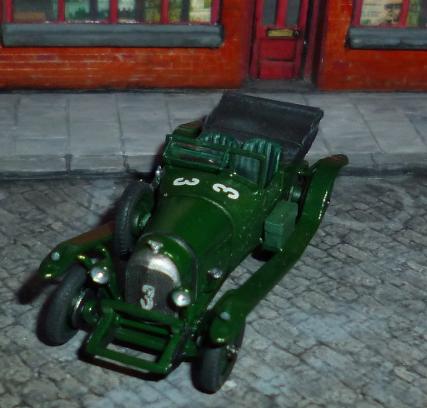





1927 le mans
Since the splendid victory in 1924 Bentley had endured little good fortune at le Mans. Crashes and mechanical failures had robbed the team of good results and for 1927 the team were determined to turn that around. W.O. Bentley entered a strong team of two 3-litre Super Sports and a new prototype car being a long-wheelbase 3-litre chassis, ch# ST3001 reg’no. YH3196, but with a 4½-litre, 4-cylinder based on the design of the new straight six-cylinder engine. This new engine could generate 115bhp while the 3-litre engines could now put out 88bhp, quite a big difference, this new car would go on to be nicknamed “Old Mother Gun”. Apparently, this is down to Woolf Barnato, who purchased the car, thinking the chassis number rhymed with the nickname; "S-T-Three-O-O-One, Old Mother Gun".
Driven by Frank Clement and Leslie Callingham the ‘prototype’ 4.5-Litre car wearing race #1, was expected to lead the team to victory. Of the 3-Litre cars, the younger car wearing race #2 would be driven by the Frenchman Baron André d'Erlanger and George Duller, ch# ML1501 reg’ no. YF2503, while the 1926 3-Litre car that had crashed in the last hour of the previous years’ race, ch# LM1344 reg’no. MK5206 known as “Old Number 7”, would be driven by Dudley Benjafield and ‘Sammy’ Davis and would carry race #3. Leaving no stone unturned in their search for performance Bentley even filmed their pitstops in order to look for things they could improve, and, a concerted effort was made to reduce the time it took to put up the cars’ hoods by holding practice sessions for the task.
The 5th Grand Prix of Endurance, and the final race of the third biennial Rudge-Whitworth Cup, was organised by the Automobile Club de l'Ouest at, as usual, the 17.262kilometer Circuit de la Sarthe. Bentley were the pre-race favourites as several of their French rivals, notably Chenard-Walcker, Lorraine-Dietrich and Peugeot, had not entered the race. It is worth noting that at this time only the overall victory was what mattered to people, it took some time for ‘class’ victories to claim the plaudits they deserved.
Initial entries numbered 31 but when it came to practice only 25 cars took part. On the plus side, all 25 qualified.
On the race day came more withdrawals by competitors. Of the original entries the 3-litre Steyr never arrived, Rolland-Pilain withdrew their three, 2-litre, cars and O.M. withdrawn their two cars due to one of their engineers having been killed during practice. One of the front-wheel driven Tractas was lost due to a practice accident too. Bentley’s competition in the 3-Litre class would now be the sole 3-Litre Aries being driven by Robert Laly and Jean Chassagne. In short only 22 cars took the start.
Preceded by a lap of honour for the 1926 race winning Lorraine-Dietrich, the race, held over the 18th and 19th of June, 1927, started at the usual 4pm local time, with the drop of the French tricolour flag; Émile Coquille, co-organiser and sponsor Rudge-Whitworth’s representative, doing the honours. The drivers ran across the track, put up the hoods, which had to remain up for the first 20 laps of the race, equating to around three hours of running, started their machines themselves and set off.
Proving the value of the Bentley drivers' hood-raising practice the Bentley of Frank Clement was first away, followed by team mates Benjafield and d'Erlanger in a Bentley 1-2-3. The Bentley’s continued in this way for quite some time with the 4.5-litre car proving its speed as Clement broke the circuit record in only the second tour. He went on to further reduce the lap record to a time of 8m46s, an average speed of 73.39mph, for the 10.7mile (17.3km) circuit; something made all the more remarkable by the fact the car was running in the ‘hood up’ configuration with all the drag that entailed.
Bentley’s team formation was followed, at some distance, by the Aries of Laly fourth, in turn followed in the running order by the Salmson teams three 1100cc cars, de Victor, de Marmier and Casse running in formation at a faster pace than the 2-litre Fasto of Brosselin and the 6-cylinder 1500cc S.A.R.A. and the E.H.P. while Chantrel's Schneider was in 10th place.
Clement’s 4.5-litre Bentley had covered 140.8 miles by the two-hour mark, 9 more than the previous years’ race mileage and at this point Lorraine-Dietrich’s 1926 record distance looked like being seriously eclipsed. In fact, Clement lapped everyone after just 12 laps; a lap sooner than the team had calculated it would take.
At around 7pm, after completing 20 laps the three Bentleys could come in for fuel and to lower the drag inducing hoods. Driver changes saw L.G. Callingham take over the 4.5-litre car, S.C.H. Davis replace Benjafield and George Duller took the wheel of d’Erlanger’s third place car. Their practiced and polished pit performance allowed the team cars leave the pits with a comfortable lead, the 3-litre cars running around 15 minutes behind the big car having also put a lap on the fourth-placed Ariès. As a little side note, and reminder of the practiced professionalism of the fledgling “Bentley Boys” association, when Laly pitted his Ariès it took him six minutes just to put the hood away! Another competitor left disappointed at this point in the race was De Marmier, his Salmson would not restart after his pit stop and although he did get away with a push-start this act was later deemed illegal and the car was disqualified.
As the race went on all seemed routine for the race organisers, and for that manner the Bentley team. As dusk came in at around and the late twilight was giving the drivers enough concerns, rain started, drizzling at first. Then, according to contemporary French newspaper accounts at close to the 5th hour, now most generally agreed around 9.40pm came the event for which the 1927 le Mans 24hrs race has become overshadowed by. “The White house crash”.
So, the Bentley’s have all put a lap on the field and a comfortably running at the front in the expected team order, suggesting the smart money was correct in making them favourites. But fate doesn’t care and the racing God’s happily threw a spanner in the works.
Pierre Tabourin driving the #11 Theophile Schneider had been delayed early in the race and was pushing hard to regain the lost time. For reference he had completed 25 laps, while the #1 Bentley leading the race had covered 34 laps. In the dark drizzly weather, and put off line while being overtaken, hit the wall of a trackside building and span his car at the tricky Maison Blanche ("White House") curves that run onto the pit straight. Coming to rest broadside across the track at the exit of the curves, and clearly blocking much of the circuit, Tabourin's Th.Schneider was hidden from view of any approaching driver. Disaster was looming for Bentley team who were bearing down on the location at speed.
Callingham, in the 4.5-litre Bentley followed Tambourin into the curves, at around 110kph according to French newspaper ‘Le Temp’, swerved to avoid the stationary #11 Th.Schneider running into the ditch on the other side of the road in an 70mph crash. The force of the incident threw Callingham out of the car leaving him lying in the centre of the track. George Duller in the #2 Bentley was not so lucky. He too elected to use the ditch rather than hit the Th.Schneider, the result being his car hit the 4.5-litre Bentley and knocked it out of the ditch back onto the circuit replacing it in the ditch. Duller himself jumping out over the steering wheel of his car, coming to rest in a very dazed state on the other side of the roadside hedge.
Sammy Davis then arrived in the #3 Bentley, according to him ““flat out”, as he entered the curves but quickly feeling something was wrong and lifting off. In attempting to avoid the #11 Th.Schneider he threw his car into a slide and hit the #1 Bentley with his cars’ front right.
Thelusson, in one of the Fastos, arrived next and somehow managed to get through all the wrecked cars with only a slight glancing impact! The other Th.Schneider, the small engined Ariès and an two S.A.R.A.s all arrived on the scene with only one of the S.A.R.A.’s managing to escape the pile up.
George Duller, dazed and staggering, had set off to warn approaching drivers, eventually realising he wasn’t on the road side of the hedge. Sammy Davis survey the scene and set about trying to find all his team mates and check on the other cars drivers too. Only when he knew Duller, Callingham and all the other drivers, were alive did Davis even think about extricating his machine from the wreckage to try and get it back to the pits.
Suffice to say, this amazing 7 car pile-up altered the whole complexion of the race having almost wiped out the entire Bentley team. ‘Amazing’ you say? Well; yes. Only Pierre Tabourin had any serious injuries which, once he was properly assessed in hospital, were found to be only a broken arm and some broken ribs. It could all have been so much more terrible.
As a little side note there don’t seem to be any photographs of the pile up at all. This suggests the organisers, and people on the spot, took the seriousness of situation to heart and cleared the road very quickly. Kudos to those who put safety ahead of photos, a lesson for today’s world, perhaps.
Having somehow untangled his damaged #3 Bentley from the pile and limped it back to the pits Davis and the team started the assessment of the damage; and whether it could continue in the race. It is important to remember that the only person who could do any work on the car was the nominated driver at the time, and, only using the tools and equipment carried on the car. But at least the team mechanics were allowed to give advice.
“Old Number Seven” was in a bad way. The list of damage was extensive, and worrisome. The right front wheel was bent, so was the front axle, a dumbiron and the chassis was twisted too. All of that meant the steering pulled badly to the right. Equally awkward was the braking, which no longer compensated between the wheels. Cosmetic damage like the dents in the body panels and badly mangled front right wing weren’t such a problem but the shattered right headlamp was broken beyond repair; not ideal for driving at speed through the rest of the night.
Sammy Davis got the car mobile using muscle power and string to reposition and secure the wing, and taped a torch to the right side of the windscreen to help illuminate that side of the car in the absence of the headlamp. Emergency repairs took half an hour and no one could be sure the car would hold together at speed. Davis volunteered to drive the car for a few cautious exploratory laps and see how it felt. Six laps later Davis returned to the pits for the scheduled driver swap back to co-driver Dr. Benjafield. Obviously with a full description of the issues and compensations required.
Benjafield retook the wheel at midnight and resumed racing. By now the only competitor the Bentley had in its class was the French Ariès now being driven by Jean Chassagne and Robert Laly, which had of course taken the lead by six laps. The damaged S.A.R.A. had also got back in the race only to have the heartbreak of being disqualified at half-race distance being shy of its required race distance by just 3 laps. A similar fate befell the two smaller Ariès too. Out of respect the other Th.Schneider #12 car of Chanterelle and Schlitz, was withdrawn once the extent of Tabourin's injuries were known.
The rain had deteriorated into a heavy thunderstorm playing havoc with the field enticing some drivers to pull over and wait out the storm. Benjafied however, only had one thought in his head and pushed his aching car as much as he dared having only one headlamp and a torch with which to see through the gloom. Becoming more and more at ease with the cars’ issues Benjafield picked up his pace and started drawing in the Ariès as the heavy rain eased off with the coming of dawn at around 5.30am. At this point the running order was #4 Ariès Type S GP2 Surbaisée of Robert Laly and Jean Chassagne, the #3 Bentley of Davis and Benjafield, third was Brosselin and Thelussen’s #9 Fasto, also having been repaired after the white house crash. Running fourth and fifth were the two remaining Salmsons and two more Fastos running in sixth and seventh.
As the morning past the Chassagne/Laly Ariès maintained a 4-lap lead. Old Number Seven, battle scared as it was, kept up its surprisingly fast and consistent pace, despite Davis having had to stop again to work on the cars flailing right-hand wing parts. The Fasto team then lost its three cars, the #9 car that had survived the big crash at Maison Blanc retired with a broken magneto on its 72nd tour. Three laps later the #10 car of Michel Doré and Roger Hellot broke a valve spring; a failure that also took out the #8 Fasto of Raymond Leroy and Pierre Mesnel after 96 laps, in the 20th hour of the race. Heartbreak for the Fabrique Automobile de St Ouen team.
Drama then engulfed the Ariès team just after midday as the #4 Laly/Chassagne car was in the pits with an ignition system problem. Twenty-five agonising minutes were spent diagnosing and fixing the issue before the car re-joined the race. Desperate to keep the crippled Bentley at bay the team put in consistently fast laps. With around two hours remaining the gap to the Bentley had reduced to 3m27sec’, forcing the pace of the Ariès, and ultimately causing the overhead camshaft drive to brake stranding Chassagne out on the circuit at 2.30pm and steeling away the victory; and in fairness, robbing the spectators of a potentially climactic finish.
Benjafield immediately backed off his pace to nurse home the battered Bentley. With 15mins to go Dr. Benjafield came into the pits to give Sammy Davis the honour of receiving the chequered flag. After all it had been Davis who had done so much to get the car back to the pits, make it manageable to drive and get it back in the race.
When the two Salmson Grand Sports of de Victor/Hasley and Casse/Rousseau finished, in 2nd and 3rd places respectively, they were 20 laps behind the Bentley.
4th place was gained by the #15 4-litre S.C.A.P. (Société de Construction Automobile Parisienne), driven by Desvaux and Vallon.
5th went to the little 1100cc E.H.P. Type DS #26 driven by Bouriat & Bussienne of Établissements Henri Précloux.
6th position fell to the #21 1100cc air-cooled 4-cylinder S.A.R.A., Société des Applications à Refroidissements par Air, or Air Cooled Applications company in English, of Maraudet & Lecureul.
7th place, and last of the classified runners, was by the front-wheel drive 1100cc Tracta driven by Gregoire and Lemesle.
On paper it looks like a dominant victory, in reality it was a hard-earned result in a race that had such a high attrition rate only eight cars actually made it to the finish; and one of them wasn’t classified due to not reaching the target lap distance for their class. Bentley also profited from the early race pace of Frank Clement. Setting the fastest lap garnered two FF1000 prizes put up by the French Automobile Club du Nord and Morris-Léon Bollée.
S. C. H. "Sammy" Davis and Dr. Dudley Benjafield had secured Bentley's 2nd victory in this 24hr endurance classic. They completed 137 laps for a total of 2369.807kilometers, or 1072.6miles if you prefer. The average speed achieved for the distance being 98.74kph, or 61.35mph, in a year old 3-litre Bentley Super Sports running on Dunlop tyres that had crashed in last hour of the 1926 edition of the race. The result was historic for Britain as well as Bentley and made "Old Number 7", chassis # LM1344 engine # LM1341 registration no. ‘MK 5206’ arguably the most famous of the racing 3-litres. Certainly as much a hero as the drivers themselves. Incidentally their target distance for the 24hrs was 129 laps; they achieved 137 laps despite the crash!
But for the heroic efforts of Davis, backed up by Benjafield, the most unlikely overall le Mans 24hr victory of all time might have seen the little 1.1-litre Salmsons win. Georges Casse & André Rousseau’s #23 Salmson Grand Sport did secure the 1926-27 Coupe Biennale Rudge-Whitworth for the Société des Moteurs Salmson team, and the team also took the 1927 Index of Performance (Prix Saint-Didier) thanks to the #25 Salmson Grand Sport driven by André de Victor of Jean Hasley.
The team with arguably the most to be down hearted about was Fabrique Automobile de St Ouen. Their three cars put in an admirable performance and deserved better luck. As it happens, Thelussin & Brosseau were able to grab a fourth overall at the later Spa 24-Hours and the team took a class win at the Montlhéry 24-Hour race. Perhaps thinking they had proved their point the Fasto team then withdrew from racing altogether.
As an event, the 1927 le Mans 24hr race was slower, and covered less distance, than the previous years’ race. But the dramatic events at Maison Blanche, and the honourable actions of Sammy Davis (amongst others), garnered a huge amount of press coverage. Far more than the previous year.
For some people the 1927 Le Mans victory was one of the most glorious events in British motor-racing history. Not least in that the perception of the ‘The Bentley Boys’ as a bunch of fast-living, party loving amateurs was exposed as a façade that hid the truth that these young men were clearly honourable, shown by the actions of Duller and Davis in the moments after the White House Crash, with a professional attitude, shown by their participation in practicing putting up the hoods and pit-stop drills, as well as teamwork in getting the #3 car back to the pits and back into the race.
When they arrived back in Britain the Bentley team were national heroes that embodied the best of the nations’ character in their decency and determination when the chips were down. The British motoring press heralded the team and result as something “of which all concerned may feel pretty proud”. Considering there was nowhere in the UK where a 24hr event could be held, it being against the law to block the national highways and Brooklands had to stop racing at night due to noise abatement law, it was an amazing achievement for a tiny British firm that wasn’t even ten years old!
Motor Sport reported: “The victory, in spite of its accident of the crippled 3-litre Bentley driven by J.D. Benjafield and S.C.H. Davis, will always remain an epic, and even if the competition was not as keen as in the past, it is great thing to have won a race with a car which was damaged in the early part of the event.”
Autocar magazine set up an expensive post-race party at the Savoy Hotel. When the toast ‘to someone who should be present’ was made, Savoy staff wheeled the battle-scarred Bentley, complete with all the mud and grime of victory, into the dining room as a grand guest of honour. “Old Number 7”, which had come so close to winning le Mans in 1926, was a hero in its own right.
The British racing press also challenged other British firms to get involved with continental motor racing by saying: “British manufacturers, therefore, have only themselves to blame if the world comes to think that the Bentley is the only British car worth mentioning.”
The most notable compliment, if arguably somewhat backhanded, came from Ettore Bugatti. He simply referred to the Bentley as “the fastest lorry in the world.” What no one knew at the time was, this was just the start of Bentleys domination of le Mans.
The lone 4½-liter “Old Mother Gun”, taken out in the White House corner crash, would be back to win le Mans in 1928, and take second place in 1929 behind Bentley’s new 6.6-Litre, straight 6-cylynder engined, Speed Six car. Chassis # ST 3001 also won the 1927 running of the 24hr Grand Prix of Paris, held at the high speed Montlhery circuit. Frank Clement and George Duller brought the car home after covering 1247.7miles, some 175miles more than the le Mans winning car managed in 24hrs, and 80miles ahead of the second-place car, a B.N.C. driven by Doré & Pousse.
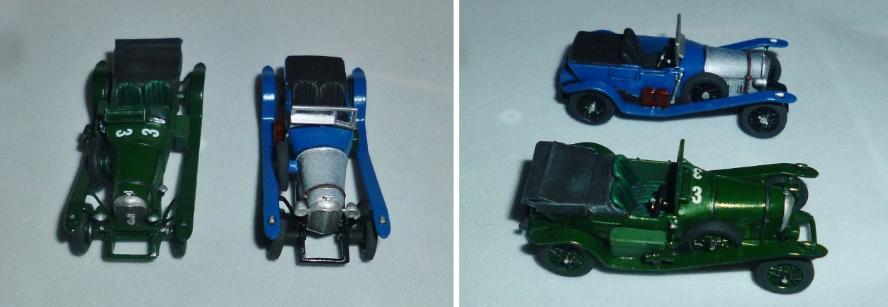
After 1927
Bentley would go on to win le Mans three more times before the firm withdrew from racing late in 1930. Having also won the Brooklands 500 in 1929, and the prestigious Brooklands Double Twelve in 1930.
Bentleys team withdrawal didn’t mean people stopped racing Bentleys. Tim Birkin pared back one of the 4.5-litre ‘Blower’ Bentleys to a streamlined single-seater in order to attain a lap record for Brooklands in 1932; it was a stunning 137.96mph. Talking of ‘Blower’ Bentleys, Birkin also took one to Pau for the 1930 French GP. Round the tight and twisty street circuit he bested a host thoroughbred GP cars, including Bugatti type 35s, to finish 2nd in an event the big car had no place doing nearly so well at.
Later in the 1930s lady driver Margaret Allan also raced a 4.5-litre Bentley to victory in the ‘Junior Long Handicap’, at Brooklands Easter Meeting of 1934. Brooklands having given up their policy of no lady drivers in 1928! Margaret Mabel Gladys Jennings, née Allan, was in the select group of just four women ever to earn the 120mph badge at Brooklands.
Of course, there are many other racing and record breaking result within the firms history. Not least the return to le Mans in 2001 garnering a 3rd place, 4th in 2002 and a further le Mans 24hr victory in 2003 for the Bentley Speed 8 of Tom Kristensen, Rinaldo Capello and Guy Smith.
Conclusion
Bentley motors Ltd., W.O. Bentley and “the Bentley Boys”, racing exploits cemented the marque's reputation for high-performance and endurance. At the same time, they generated a wealth of front-page headlines that effectively put Britain amongst the world’s racing elite, and, British manufacturers products into the minds of the world’s car buying public; a public hitherto thinking France, Germany and Italy were the only countries that could build decent racing GP and sports cars.
After claiming they had learned enough about speed and reliability from the five le Mans victories, Bentley withdrew from motor racing. This may well have been an excuse given the great depression and Bentley’s woeful financial position which resulted in them soon being quietly acquired by Rolls-Royce. All the same, the competition and record results are astonishing for a firm barely 10 years old.
Visionary engineering, and the courage and determination of the racing team, not to mention Woolf Barnato and ‘the Blue Train Races’, set Bentley apart from Rolls-Royce. Equally elegant and refined, equally reliable, Bentley held that special place in the publics heart that Rolls-Royce inhabited in Royalty. The formidable racing reputation excited everyone, whether they could afford such a car or not, and even today those early Bentleys feature highly on the dream car wish lists of automotive enthusiasts.
Sophistication came with time, and playing second fiddle as badge engineered Rolls-Royce models. Yet, to this day, Bentley will hark back to le mans for model names or advertising inspiration. It is more than fair to say that, although not the primary aim of the firm when W.O. created it, without racing, Bentley may never have survived at all.
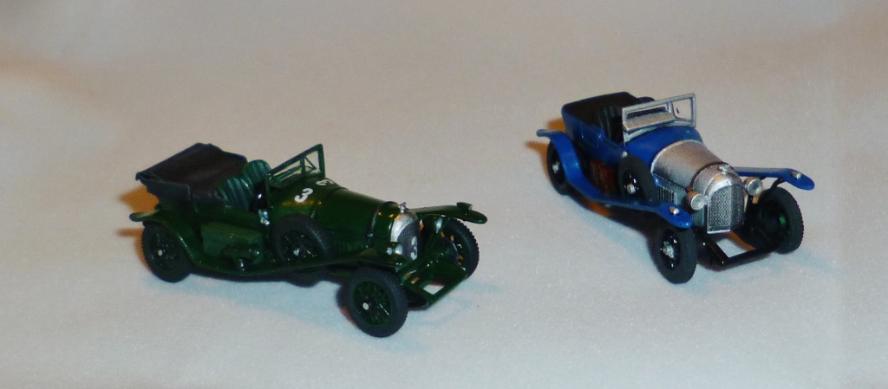



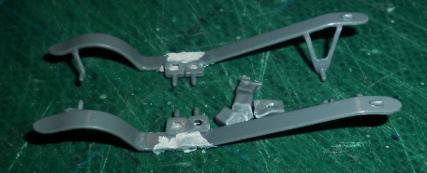

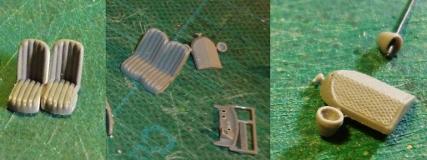



Designed by R&L, Rosenhain and Lipmann, of Melbourne, Australia, these kits were not only used as part of a Jet petrol promotion campaign but also in cereal promotions too. These events led to many kits being around back in the 1970s and, like many such ‘toy’ items, most probably ended up in the bin. R&L made a lot of such soft plastic models across a wide range of subjects including trains, aircraft, space craft, sailing ships, tugs, figures, animals and much more. Largely aimed at children, being simple push together designs the models were quick and easy to build. They are surprisingly accurate and nicely detailed so they can be built into very nice little models, however, they are now much harder to come by and prices for them can be quite steep.
Interestingly the plastics different in their compositions. The Jet ones being a softer plastic, and each car having a different but suitable colour, while the cereal promo kits were moulded in a harder grey plastic. The latter being easier to work with from a scale modellers point of view but either type can still be built into a nice model.
The original set consisted of ten cars from the pioneers to around 1930, but in 1975 Aurora released a set of just 4 of the cars as Snap-a-roos 'OLD TIMERS' set # 9258. This set also included the 1927 Bentley, along with the 1912Packard, 1913 Sunbeam and 1901 Oldsmobile.
Our kit was purchased from ebay seller in late November 2022 some 50 years after the initial Jet promo release. It cost £6.99 + £4.50 P&P; £11.49 in total. Given that this is the only one missing from our set of ten Ian decided to buy one while he had the chance as these rare little models have been seen advertised for considerably more in their mint Jet Promo packaging.
The blue road going Bentley was built straight from the packet during Jan/Feb 2023 Ian used Alclad II black primer, chrome and clear and Zero paints Tyrrell blue, all applied by airbrush. Detail painting was done with a brush using acrylic colours from the Deco-Art range.
Our 1927 le Mans winner version built from this same kit, finished February 17th 2023, was corrected and detailed to be a more accurate model than the kit offering. Note the different boxes on the running boards, the scratch-built klaxon and heavily modified windscreen too. Other details can be seen at the rear of the model with the new racing number disc and light bar, and at the front with the addition of an actual front beam axel, drilled out head lights and scratch-built side lights. On the inside the dash was amended and the steering wheel detailed as well as the seats being separated and staggered. Finally, the tonneau cover was remade and folded in behind the seats before a whole new hood was scratch built from plastic framing to paper cover, folded back on itself to replicate what could be seen in photo’s of the car during the race.
Ian again used Alclad II black primer, chrome and clear, and Zero paints TWR Jaguar green all applied by airbrush. Detail painting was done with a brush using acrylic colours from the Deco-Art range.
RETURN TO:-

